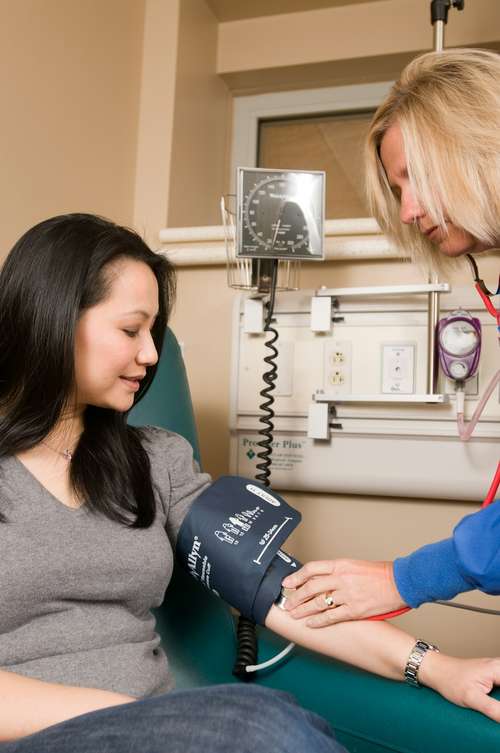 A 3D model of the nanostructure fabricated by the scientists at the University of Melbourne. Shown is a less than 200nm thick array of so called ‘nanorods’ that allows the device to visualize transparent objects like biological cells.[/caption]
"The advantage of being able to visualize cells with this type of apparatus is that they can be living and do not require any processing before being visualized. Real-time and without the need for computational processing. Ann Roberts, co-author of the paper, TMOS chief investigator, and professor at the University of Melbourne, claims that the gadget does all the work.
This innovative gadget may enable at-home disease diagnosis in addition to remote medical diagnostics. Patients might collect their own samples from a drop of blood or saliva and send the image to a laboratory anywhere in the world for evaluation and quick diagnosis.
"Early diagnosis could enable prompt treatment and improve health outcomes. Smaller, more affordable, and portable medical diagnostic tools will enable underserved areas to receive healthcare that is currently exclusively available to first-world nations, Roberts continues.
The current gadget prototype's fabrication cost, which includes the utilization of tools also utilized in the production of electrical computer chips, is about US$700. To commercialize the gadget, the researchers claim that they are seeking industrial partnership.
Wesemann tells SciDev.Net, "We're hopeful that in the near future we can design manufacturing processes that are better suitable for mass manufacture and lower the device cost down to perhaps a few cents."
It is a fairly basic technology that any engineer may learn and incorporate into any mobile medical imaging equipment; a smartphone is not necessary.
"This is a new imaging modality, and the feasibility of such optical phase imaging using incident light is promising, as there are many almost transparent tissues that are hard to image without contrast or radiation," says Michael Abramoff, an ophthalmologist, computer engineer, and founder and executive chairman of the US-based Digital Diagnostics company.
Since the retina is the only organ where neuronal and vascular tissue can be scanned concurrently, we anticipate using this modality on biological tissue.
A 3D model of the nanostructure fabricated by the scientists at the University of Melbourne. Shown is a less than 200nm thick array of so called ‘nanorods’ that allows the device to visualize transparent objects like biological cells.[/caption]
"The advantage of being able to visualize cells with this type of apparatus is that they can be living and do not require any processing before being visualized. Real-time and without the need for computational processing. Ann Roberts, co-author of the paper, TMOS chief investigator, and professor at the University of Melbourne, claims that the gadget does all the work.
This innovative gadget may enable at-home disease diagnosis in addition to remote medical diagnostics. Patients might collect their own samples from a drop of blood or saliva and send the image to a laboratory anywhere in the world for evaluation and quick diagnosis.
"Early diagnosis could enable prompt treatment and improve health outcomes. Smaller, more affordable, and portable medical diagnostic tools will enable underserved areas to receive healthcare that is currently exclusively available to first-world nations, Roberts continues.
The current gadget prototype's fabrication cost, which includes the utilization of tools also utilized in the production of electrical computer chips, is about US$700. To commercialize the gadget, the researchers claim that they are seeking industrial partnership.
Wesemann tells SciDev.Net, "We're hopeful that in the near future we can design manufacturing processes that are better suitable for mass manufacture and lower the device cost down to perhaps a few cents."
It is a fairly basic technology that any engineer may learn and incorporate into any mobile medical imaging equipment; a smartphone is not necessary.
"This is a new imaging modality, and the feasibility of such optical phase imaging using incident light is promising, as there are many almost transparent tissues that are hard to image without contrast or radiation," says Michael Abramoff, an ophthalmologist, computer engineer, and founder and executive chairman of the US-based Digital Diagnostics company.
Since the retina is the only organ where neuronal and vascular tissue can be scanned concurrently, we anticipate using this modality on biological tissue.
Nanotechnology using smartphone camera to detect diseases
By
Josh Piers

According to Australian scientists who created it, a nanotech imaging gadget that is small enough to fit on a smartphone camera lens has the potential to make the detection of specific diseases accessible and inexpensive for individuals in rural and distant areas.
The World Health Organization has urged nations to prioritize expenditures in high-quality diagnostics as the first stage in the control, treatment, and prevention of disease. The COVID-19 pandemic has thrown diagnostics into sharp focus.
The device's specifications were described in the journal ACS Photonics by researchers from the University of Melbourne and the Australian Research Council Centre of Excellence for Transformative Meta-Optical Systems (TMOS).
Currently, optical microscopes are the primary tools used to look for disease-related alterations in biological cells. According to Lukas Wesemann, the study's lead author and research fellow at the University of Melbourne and TMOS, "it often entails labeling the cells with chemicals in a laboratory environment and using high-end microscopes, which are bulky and expensive."
The use of metasurfaces, which can control the light traveling through them to make unseen elements of objects, such active biological cells, visible, has allowed the researchers to miniaturize phase-imaging technology. Phase-imaging depends on the tissues or cells being studied having different levels of transparency.
Our thin, flat optical device, which is only a few hundred nanometers thick, is capable of carrying out the same type of microscopy procedure that is frequently employed to study living things. It can be mounted on top of a camera lens to assist in identifying biological cell changes that are suggestive of disorders, according to Wesemann.
Future applications of this technology could include the detection of diseases that can be seen using optical microscopy, including malaria, leishmaniasis, trypanosomiasis, and babesiosis.
[caption id="attachment_12101" align="aligncenter" width="745"] A 3D model of the nanostructure fabricated by the scientists at the University of Melbourne. Shown is a less than 200nm thick array of so called ‘nanorods’ that allows the device to visualize transparent objects like biological cells.[/caption]
"The advantage of being able to visualize cells with this type of apparatus is that they can be living and do not require any processing before being visualized. Real-time and without the need for computational processing. Ann Roberts, co-author of the paper, TMOS chief investigator, and professor at the University of Melbourne, claims that the gadget does all the work.
This innovative gadget may enable at-home disease diagnosis in addition to remote medical diagnostics. Patients might collect their own samples from a drop of blood or saliva and send the image to a laboratory anywhere in the world for evaluation and quick diagnosis.
"Early diagnosis could enable prompt treatment and improve health outcomes. Smaller, more affordable, and portable medical diagnostic tools will enable underserved areas to receive healthcare that is currently exclusively available to first-world nations, Roberts continues.
The current gadget prototype's fabrication cost, which includes the utilization of tools also utilized in the production of electrical computer chips, is about US$700. To commercialize the gadget, the researchers claim that they are seeking industrial partnership.
Wesemann tells SciDev.Net, "We're hopeful that in the near future we can design manufacturing processes that are better suitable for mass manufacture and lower the device cost down to perhaps a few cents."
It is a fairly basic technology that any engineer may learn and incorporate into any mobile medical imaging equipment; a smartphone is not necessary.
"This is a new imaging modality, and the feasibility of such optical phase imaging using incident light is promising, as there are many almost transparent tissues that are hard to image without contrast or radiation," says Michael Abramoff, an ophthalmologist, computer engineer, and founder and executive chairman of the US-based Digital Diagnostics company.
Since the retina is the only organ where neuronal and vascular tissue can be scanned concurrently, we anticipate using this modality on biological tissue.
A 3D model of the nanostructure fabricated by the scientists at the University of Melbourne. Shown is a less than 200nm thick array of so called ‘nanorods’ that allows the device to visualize transparent objects like biological cells.[/caption]
"The advantage of being able to visualize cells with this type of apparatus is that they can be living and do not require any processing before being visualized. Real-time and without the need for computational processing. Ann Roberts, co-author of the paper, TMOS chief investigator, and professor at the University of Melbourne, claims that the gadget does all the work.
This innovative gadget may enable at-home disease diagnosis in addition to remote medical diagnostics. Patients might collect their own samples from a drop of blood or saliva and send the image to a laboratory anywhere in the world for evaluation and quick diagnosis.
"Early diagnosis could enable prompt treatment and improve health outcomes. Smaller, more affordable, and portable medical diagnostic tools will enable underserved areas to receive healthcare that is currently exclusively available to first-world nations, Roberts continues.
The current gadget prototype's fabrication cost, which includes the utilization of tools also utilized in the production of electrical computer chips, is about US$700. To commercialize the gadget, the researchers claim that they are seeking industrial partnership.
Wesemann tells SciDev.Net, "We're hopeful that in the near future we can design manufacturing processes that are better suitable for mass manufacture and lower the device cost down to perhaps a few cents."
It is a fairly basic technology that any engineer may learn and incorporate into any mobile medical imaging equipment; a smartphone is not necessary.
"This is a new imaging modality, and the feasibility of such optical phase imaging using incident light is promising, as there are many almost transparent tissues that are hard to image without contrast or radiation," says Michael Abramoff, an ophthalmologist, computer engineer, and founder and executive chairman of the US-based Digital Diagnostics company.
Since the retina is the only organ where neuronal and vascular tissue can be scanned concurrently, we anticipate using this modality on biological tissue.
 A 3D model of the nanostructure fabricated by the scientists at the University of Melbourne. Shown is a less than 200nm thick array of so called ‘nanorods’ that allows the device to visualize transparent objects like biological cells.[/caption]
"The advantage of being able to visualize cells with this type of apparatus is that they can be living and do not require any processing before being visualized. Real-time and without the need for computational processing. Ann Roberts, co-author of the paper, TMOS chief investigator, and professor at the University of Melbourne, claims that the gadget does all the work.
This innovative gadget may enable at-home disease diagnosis in addition to remote medical diagnostics. Patients might collect their own samples from a drop of blood or saliva and send the image to a laboratory anywhere in the world for evaluation and quick diagnosis.
"Early diagnosis could enable prompt treatment and improve health outcomes. Smaller, more affordable, and portable medical diagnostic tools will enable underserved areas to receive healthcare that is currently exclusively available to first-world nations, Roberts continues.
The current gadget prototype's fabrication cost, which includes the utilization of tools also utilized in the production of electrical computer chips, is about US$700. To commercialize the gadget, the researchers claim that they are seeking industrial partnership.
Wesemann tells SciDev.Net, "We're hopeful that in the near future we can design manufacturing processes that are better suitable for mass manufacture and lower the device cost down to perhaps a few cents."
It is a fairly basic technology that any engineer may learn and incorporate into any mobile medical imaging equipment; a smartphone is not necessary.
"This is a new imaging modality, and the feasibility of such optical phase imaging using incident light is promising, as there are many almost transparent tissues that are hard to image without contrast or radiation," says Michael Abramoff, an ophthalmologist, computer engineer, and founder and executive chairman of the US-based Digital Diagnostics company.
Since the retina is the only organ where neuronal and vascular tissue can be scanned concurrently, we anticipate using this modality on biological tissue.
A 3D model of the nanostructure fabricated by the scientists at the University of Melbourne. Shown is a less than 200nm thick array of so called ‘nanorods’ that allows the device to visualize transparent objects like biological cells.[/caption]
"The advantage of being able to visualize cells with this type of apparatus is that they can be living and do not require any processing before being visualized. Real-time and without the need for computational processing. Ann Roberts, co-author of the paper, TMOS chief investigator, and professor at the University of Melbourne, claims that the gadget does all the work.
This innovative gadget may enable at-home disease diagnosis in addition to remote medical diagnostics. Patients might collect their own samples from a drop of blood or saliva and send the image to a laboratory anywhere in the world for evaluation and quick diagnosis.
"Early diagnosis could enable prompt treatment and improve health outcomes. Smaller, more affordable, and portable medical diagnostic tools will enable underserved areas to receive healthcare that is currently exclusively available to first-world nations, Roberts continues.
The current gadget prototype's fabrication cost, which includes the utilization of tools also utilized in the production of electrical computer chips, is about US$700. To commercialize the gadget, the researchers claim that they are seeking industrial partnership.
Wesemann tells SciDev.Net, "We're hopeful that in the near future we can design manufacturing processes that are better suitable for mass manufacture and lower the device cost down to perhaps a few cents."
It is a fairly basic technology that any engineer may learn and incorporate into any mobile medical imaging equipment; a smartphone is not necessary.
"This is a new imaging modality, and the feasibility of such optical phase imaging using incident light is promising, as there are many almost transparent tissues that are hard to image without contrast or radiation," says Michael Abramoff, an ophthalmologist, computer engineer, and founder and executive chairman of the US-based Digital Diagnostics company.
Since the retina is the only organ where neuronal and vascular tissue can be scanned concurrently, we anticipate using this modality on biological tissue.
Share this article
Author



